Out of school care parent survey: report
Details the views of parents/carers of five to 13 year old children regarding out of school care, including term-time and holiday care.
4. School holiday childcare
Use of holiday childcare
- The proportion of parents using childcare during the school holidays was similar to those using childcare during term-time. More than half (61%) of parents said they used childcare the school holidays.
- Most (82%) parents who used childcare during term-time also used childcare during the school holidays[21], while 36% of parents who did not use any childcare during term-time did use it during the school holidays. Twenty three percent of all parents used neither.
- Again, the working status of a family influenced the likelihood of childcare use. As shown in Table 4.1, families in which all parents were working were more likely to use holiday childcare than families in which at least one parent was not working (71%, compared with 41%). Again, single parents working full-time were the family group most likely to use holiday childcare (76%).
Table 4.1: Use of holiday care by working status
| Family working status | Use holiday childcare | Base |
|---|---|---|
| All parents working (full-time or part-time) | 71% |
1,594 |
| At least one parent not working | 41% |
408 |
| Single parent – working full-time | 76% |
144 |
| Single parent – working part-time | 70% |
108 |
| Single parent – not working | 43% |
98 |
| Couple – both working full-time | 72% |
671 |
| Couple – one parent working full-time, one working part-time; or both working part-time | 71% |
668 |
| Couple – one parent working full-time, one not working | 39% |
226 |
| Couple – neither working | 42% |
52 |
- The reasons parents used holiday childcare were very similar to those for using term-time childcare (Figure 4.1). The most common reason was because the participant and/or their partner were working, mentioned by two thirds (65%) of participants. Six per cent said that they used holiday childcare so that they did not have to take annual or unpaid leave from their work. Around one in ten used holiday childcare to give grandparents a chance to spend time with the child (11%), because the child enjoyed it (9%) or because it gave the child a chance to do other activities (8%).
Figure 4.1: Reasons for using holiday care
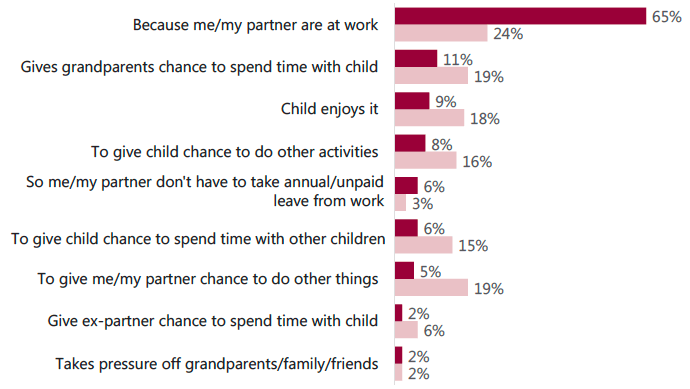
Base: All who use holiday childcare – all parents (1,296); at least one non-working parent (165) Participants could give more than one response
- Among families with at least one parent not working, the main reason for using holiday care was still because the participant or their partner was at work (24%). However, greater proportions than overall said they used holiday care because: it gave grandparents a chance to spend time with the child (19%); it gave the parents a chance to do other things (19%); their child enjoyed it (18%); it gave the child a chance to do other activities (16%); and that it gave the child a chance to spend time with other children (15%).
Types of holiday childcare used
- Among those who used childcare during the school holidays, a majority (69%) of parents only used informal childcare (mainly grandparents), while 11% only used formal care, such as playschemes/ holidays clubs or a childminder. Twenty per cent of parents used both informal and formal holiday childcare (Figure 4.2)[22].
- In terms of the use of both term-time and holiday childcare, 22% of all parents only used informal care during both term-time and the holidays, 4% only used formal care, while 4% used both.
- Again, grandparents were the most commonly used type of childcare, used by 71% of all those who used childcare during the school holidays. Playschemes/holiday clubs were used by 26% of parents, while 19% used relatives (other than older siblings or ex-partners) and 11% used friends or neighbours.
Figure 4.2: Types of holiday care used
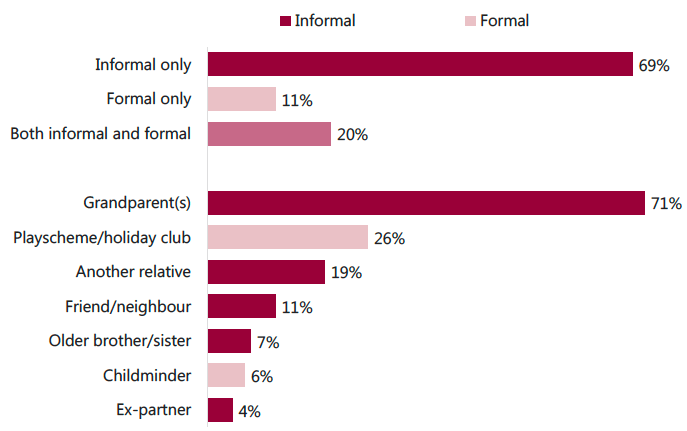
Base: All who use holiday childcare (1,296) Participants could give more than one response.
- Older children, aged 11 to 13, and those living in Central Scotland[23] or in the most deprived areas (SIMD 1) were more likely to receive informal care only during school holidays (80%, 78% and 75% respectively, compared with 69% overall). In particular, children aged 11 to 13 were more likely than younger children to be looked after by an older brother or sister (12%, compared with 5% of those aged 5 to 10). Children aged 5 to 7 were more likely to receive formal care only during school holidays (14%, compared with11% of 8 to 10 year olds, and 9% of 11 to 13 year olds) (Figure 4.3).
Figure 4.3: Types of holiday care used by age
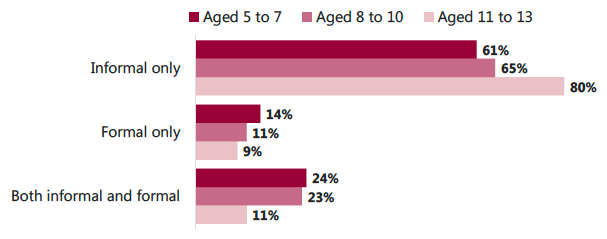
Base: All who use holiday childcare – parents of children aged 5 to 7 (434); 8 to 10 (443); 11 to 13 (419)
- Those living in the Lothians and younger children, aged 5 to 7, were more likely to to attend playschemes/holiday clubs (38% and 34% respectively, compared with26% overall). Families living in the least deprived areas (SIMD 5) and those earning more than £60,000 per annum were also more likely to use playschemes/holiday clubs (40% and 38%, compared with26% overall).
Views on playschemes / holiday clubs
- Users of playschemes/holiday were largely positive about them. As shown in Figure 4.4, convenience was a key factor, with most parents agreeing that the playscheme/club was convenient in terms of its location (91%), and the times it was available (89%). Three quarters (76%) agreed that, given their family income, it was affordable, though 16% disagreed with this statement.
- Eleven per cent of parents said that the provision of free or subsidised food was one of the reasons they used the playscheme/club, while 47% disagreed and 34% said their playscheme/club did not provide this.
- Single parents and those living in the most deprived areas (SIMD 1) were more likely to say that one of the reasons they used the playscheme/club was the provision of free or subsidised food (32% and 21% respectively, in comparison to 11% overall).
Figure 4.4: Views on playschemes / holiday clubs
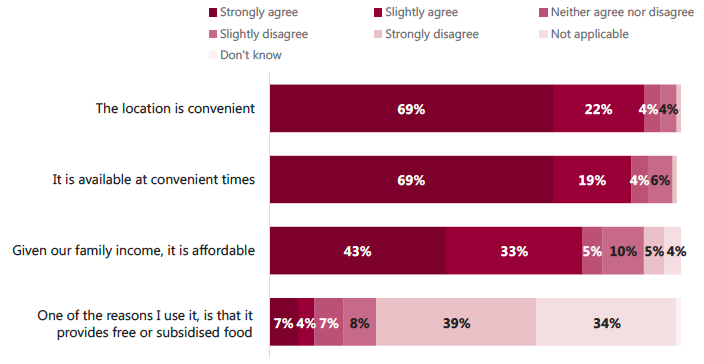
Base: All who use playscheme / holiday clubs (351)
As shown in Figure 4.5, users of holiday childcare who did not use playschemes or holiday clubs said the main reasons they used other types of care was because they thought playschemes or holiday clubs were too expensive (39%) or that they preferred family or friends to look after their child (27%). One in ten (10%) said there were no playschemes or clubs available in their area, while 5% were not aware of any in their area. Around one in ten also said their current arrangements were more convenient or accessible (10%), that the timings of the playscheme/club were not convenient (8%), or that their child did not like it (8%).
Figure 4.5: Reasons for not using playschemes / holiday clubs (among users of other types of care)
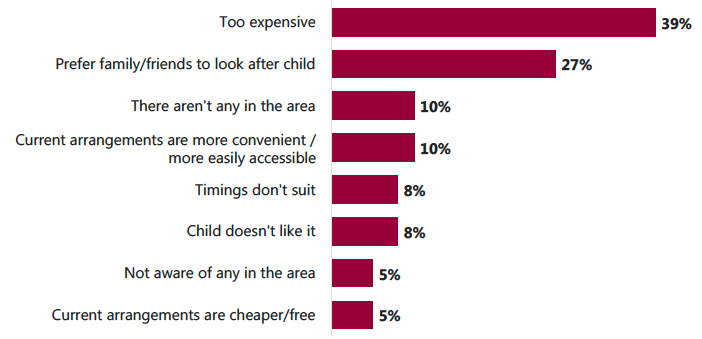
Base: All who use holiday childcare but do not use playschemes or holiday clubs (945) Participants could give more than one response.
- Parents living in remote rural locations and in the Highlands and Islands were more likely to say that there were no playschemes or holiday clubs in their area (45% and 32% respectively, compared with10% overall), while those in areas of mid-level deprivation (SIMD 3) were more likely to say they were not aware of any playschemes/clubs in their area (8%, compared with5% overall).
Non-users of holiday care
- Thirty nine per cent of parents did not use any type of holiday childcare and the profile of these parents was very similar to non-users of term-time childcare. Those who did not use holiday childcare were more likely to be in families with a least one non-working parent (59%), families earning less than £15,000 per annum (54%) or those living in the most deprived areas (SIMD 1) (49%).
- Families with three or more children were also less likely to use holiday care than smaller families (54% did not use holiday childcare, compared with36% of families with one or two children).
- By far the main reason for not using holiday childcare was because it was not currently needed, since parents could look after the child themselves (82%) (Figure 4.6). Much smaller proportions said that they could not afford this type of childcare (12%) or that there was no other holiday childcare available to them nearby (4%).
Figure 4.6: Reasons for not using holiday childcare
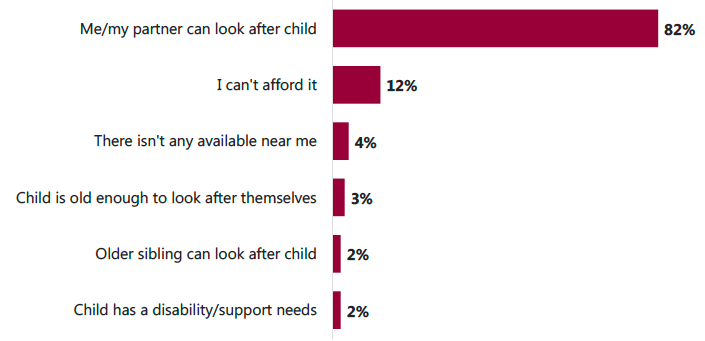
Base: All who do not use holiday childcare (706) Participants could give more than one response.
Those living in remote rural locations were more likely to say there were no available playschemes or holiday clubs near to them (18%, compared with 4% overall).
Accessing playschemes/holiday clubs
The majority (64%) of parents who did not use any holiday care were aware of playschemes and holiday clubs near to them, while 19% said there were none nearby and 16% did not know of any (Figure 4.7).
Figure 4.7: Awareness of nearby playschemes or holiday clubs

Base: All who do not use holiday childcare (706)
- Parents living in the least deprived areas (SIMD 5) were more likely to say that there were playschemes or holiday clubs near to them (73%, compared with 64% overall), while those in the most deprived areas (SIMD 1) were more likely to say they did not know of any nearby playschemes/clubs (22%, compared with 16% overall). Those in remote rural locations were more likely to say there were no nearby playschemes or holiday clubs (34%, compared with 19% overall).
- Among parents who said that there were playschemes or holiday clubs near to them, 64% said the playscheme/club was affordable to them, while 21% said it was not affordable and 14% did not know. Single parents and families earning less than £20,000 per annum were more likely to say that the playscheme or holiday club was not affordable (both 40%, compared with 21% overall).
- As shown in Figure 4.8, there was a considerable level of interest in affordable playschemes or holiday clubs among those with none nearby. Fifty seven per cent said they would be very/somewhat interested in using one, while 40% were not interested.
Figure 4.8: Interest in affordable playschemes or holiday clubs

Base: All who do not use holiday childcare with no nearby playschemes/holiday clubs (397)
- Those most interested in using a playscheme or holiday club were families with an income of £20,000 or less per annum (76%), single parents (70%), and parents whose child was aged 5 to 7 (70%).
- As shown in Figure 4.9, the reasons non-users gave for wanting using a club were quit different from those given by current users (see Figure 4.1). While current users of holiday care primarily said they used this care to allow them to work, non-users said the main reasons they would do so would be to give their child the chance to do other activities (50%) and to spend time with other children (49%). Smaller proportions said that it would allow them/their partner to work (13%) or to work more hours (6%), give them a chance to do other things (12%), or would reduce the need for them to take annual or unpaid leave from their work (8%).
Figure 4.9: Reasons for using an affordable playscheme or holiday club
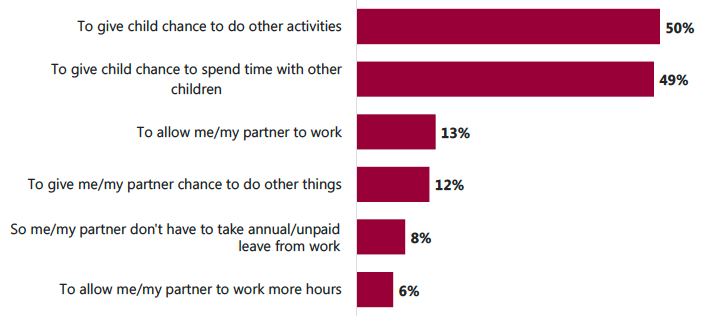
Base: All who do not use holiday childcare interested in using a playscheme/holiday club (218) Participants could give more than one response.
Contact
Email: socialresearch@gov.scot
There is a problem
Thanks for your feedback